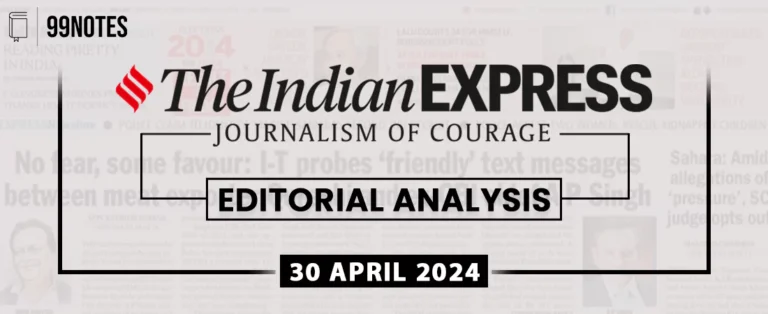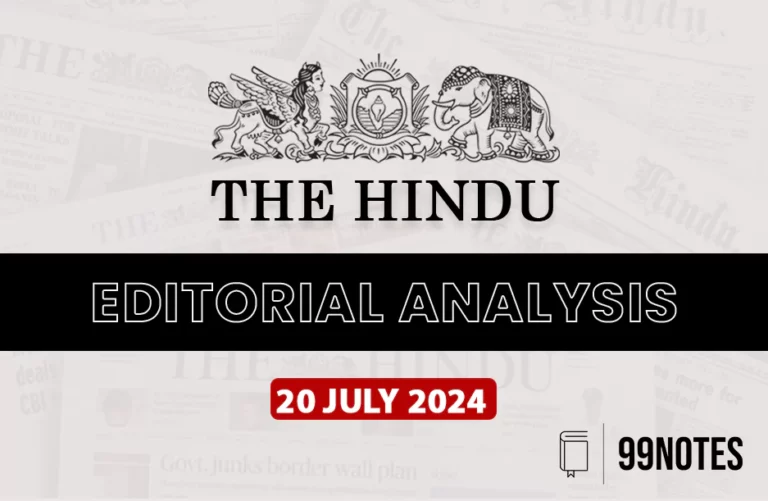22 November 2024 : Indian Express Editorial Analysis
1. Leaner, faster, fairer
(Source: Indian Express; Section: The Editorial Page; Page: 08)
| Topic: GS2 – Polity – Judiciary |
| Context: |
| The article highlights the urgent need for administrative reforms in India’s judiciary to address case backlogs and inefficiencies, emphasizing innovative solutions like performance monitoring and leveraging retired professionals. |
Why do we need Judicial Reforms?
- The Judiciary is one of three organs of government, the others being the Executive and Legislature.
- The continuous evolution of society requires these organs to continually reform and adapt to changing needs.
- Hence, the requirement for judicial reforms is a dynamic and ongoing process.
- These reforms also help ensure that the Judiciary is equipped to handle new challenges and maintain its effectiveness in promoting equality and justice for all.
The Need for Administrative Reform in the Judiciary
- The appointment of a new Chief Justice of India (CJI) presents an opportunity to tackle the administrative inefficiencies plaguing the judicial system.
- The staggering backlog of cases—over 45 million in district and subordinate courts alone—underscores the scale of the problem.
- This backlog not only delays justice but erodes public trust in the judiciary.
- The Supreme Court’s Centre for Research and Planning (CRP) has identified actionable measures like performance monitoring and categorization of judges, proposed by the current CJI, Sanjiv Khanna, which, if implemented, could be transformative.
Administrative Bottlenecks and Resource Shortages
- The judiciary’s inefficiencies are compounded by poor infrastructure and resource constraints.
- A shortage of 21% in judicial officers and 27% in non-judicial staff nationwide hampers the system’s functionality.
- In states like Bihar and Rajasthan, the shortages approach 50%. This issue is exacerbated by inadequate tools, such as the absence of video conferencing-enabled computers in half of the district courts.
- These challenges limit judicial officers’ capacity to focus on substantive work, with administrative tasks consuming 55% of their time, as demonstrated by the Delhi High Court’s Zero Pendency Courts project.
- This administrative overload perpetuates delays and undermines judicial productivity.
Lessons from Historical Projects: Leveraging External Expertise
- India’s Cataract Blindness Project from the 1990s offers valuable insights. By engaging retired armed forces personnel for logistical coordination, the project allowed ophthalmologists to concentrate solely on surgeries, resulting in a historic achievement of 11 million operations in five years.
- Similarly, in the 1960s, Delhi magistrates were able to efficiently manage judicial and administrative responsibilities under the supervision of a single District Magistrate, whose scrutiny of individual performance significantly boosted efficiency.
Inducting Retired Professionals for Judicial Administration
- One proposed solution to reduce administrative burden on judges is the induction of retired professionals from large organizations like the Indian Railways, postal services, or accounts offices.
- These retirees bring expertise in workflow management and could efficiently handle non-judicial tasks. Utilizing their skills on a temporary basis would be cost-effective and free up judicial officers for their primary work.
- Drawing on these examples, the courts could implement a similar system without requiring extensive structural changes to the legal framework.
Streamlining Case-Flow Management and Performance Monitoring
- Case-flow management remains a critical aspect of addressing delays. High courts already have rules in place for delegating functions but often lack the manpower to enforce them effectively.
- Instituting monthly reviews of case disposals, akin to the 1960s magistrates’ meetings, could motivate judicial officers and establish a culture of accountability.
- Regular performance monitoring would help identify high and low performers, aligning with Justice Khanna’s suggestions.
The Path to a Leaner, Faster, and Fairer Judiciary
- Streamlining administrative processes is not a radical idea but a pragmatic step toward judicial reform. By learning from past successes and leveraging available resources, the judiciary can achieve greater efficiency.
- Collaborative efforts involving state law secretaries, high court registrars, and retired professionals could lead to a leaner, more effective justice system.
- This approach would enable judges to focus on delivering justice, ultimately restoring faith in India’s courts—a goal that is both urgent and achievable.
| What are the current issues in the Indian Judicial System? |
|
Some important issues plaguing the Indian Judicial System are: Shortage of Judges: There is a shortage of judges in subordinate courts in India, with around 35% of posts remaining unfilled. This results in a poor judge-to-population ratio, as India has only 17 judges per million. Appointment of Judges: The judges in India are appointed and transferred via the collegium system. The system has been criticized for being opaque in its functioning. Pendency of Cases: The problem of pendency is particularly acute at the lower levels of the judiciary, where the majority of cases are filed and where the shortage of judges is most severe. Poor Condition of Infrastructure: Insufficient budget allocation results in poor infrastructure for the judiciary in India, spending only 0.09% of its GDP on maintaining the judicial infrastructure. Human Resources: Lack of efficient secretarial and clerical assistance, shortage of Public Prosecutors, etc., also adds to the problem. Lack of gender diversity: For instance, there have been only 11 women judges on the Supreme Court since its inception, and no women Chief Justices. Undertrials: According to the ‘Prison Statistics India’ report published by the National Crime Records Bureau (NCRB) in 2020, there were as many as 4,88,511 prison inmates, of whom 76% were undertrials. Procedural issues: It includes delay in service of summons/notices to accused/defendants/respondents by process servers and police. Outdated Procedural laws: The Code of Civil Procedure 1908, Code of Criminal Procedure 1973, and The Evidence Act 1872 are all outdated in relation to the current needs of society. They enable motions for adjournments which are routinely sought and given. As a result, litigation has become a prolonged, costly, uncertain, rigid process. Burden of extrajudicial work: Burdening of Judges with extra-judicial work (like Legal Services) diverts their focus and time from judicial work. |
| PYQ: Critically examine the Supreme Court’s judgement on ‘National Judicial Appointments Commission Act, 2014’ with reference to appointment of judges of higher judiciary in India. (150 words/10m) (UPSC CSE (M) GS-2 2017) |
| Practice Question: India’s judiciary faces significant administrative challenges that hinder its efficiency and delay justice. Critically analyze the measures required to streamline judicial administration, with a focus on leveraging innovative strategies and resource management. (250 words/15 m) |




